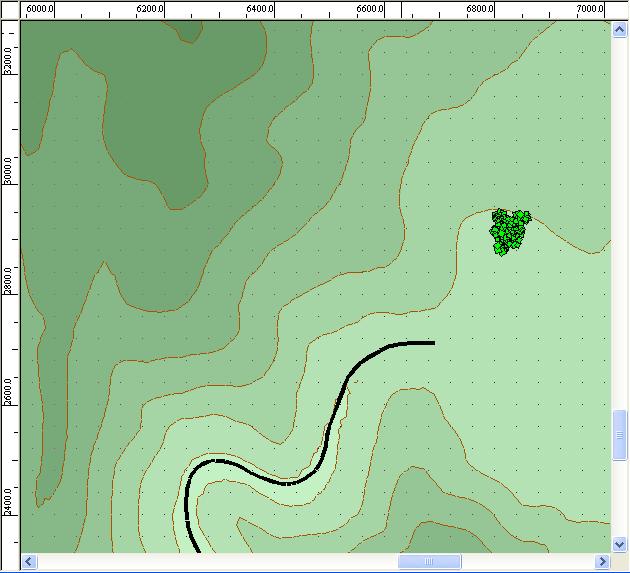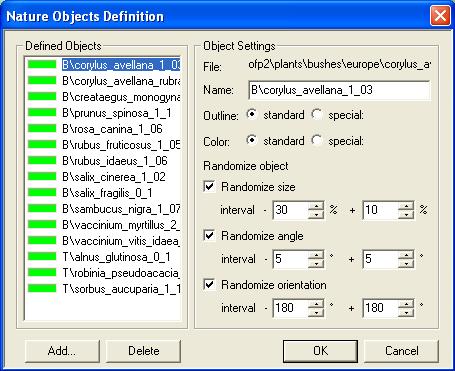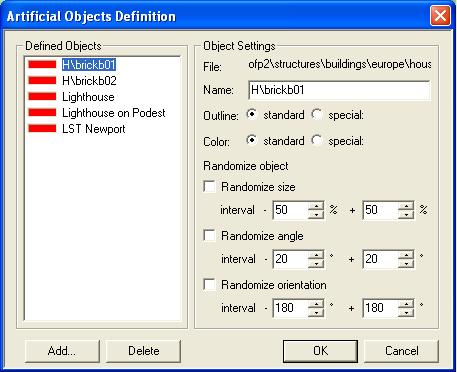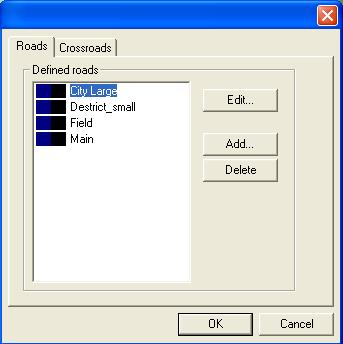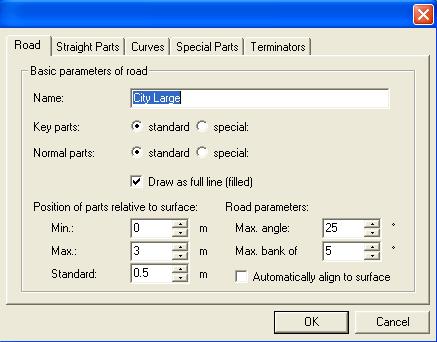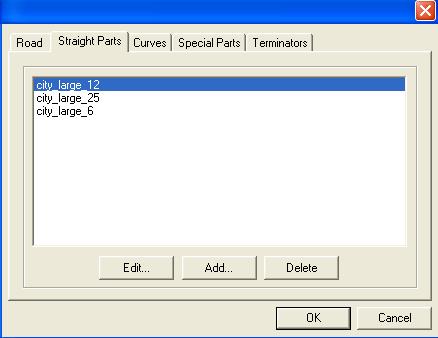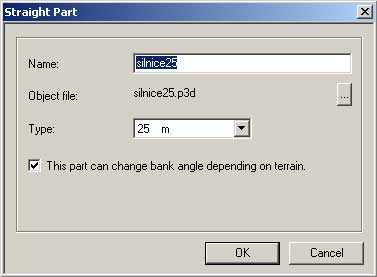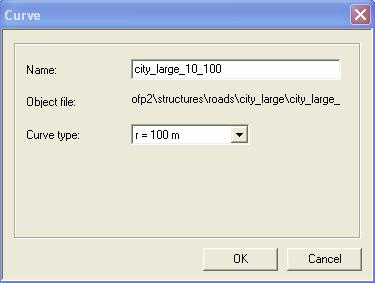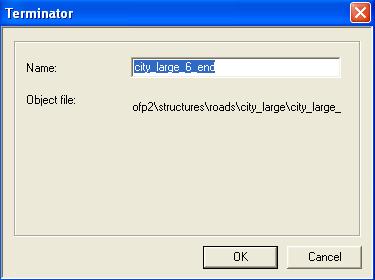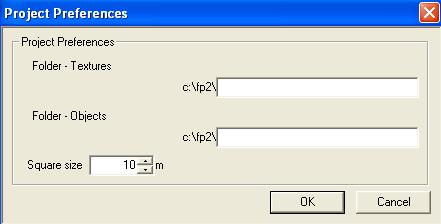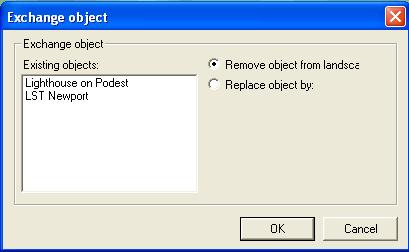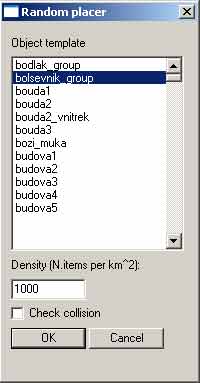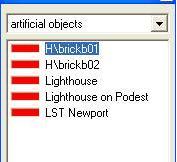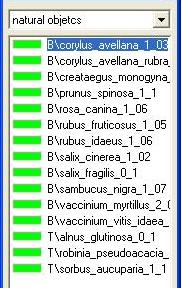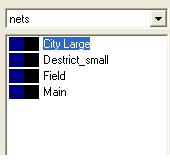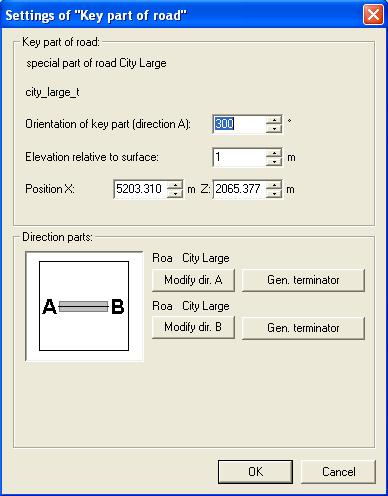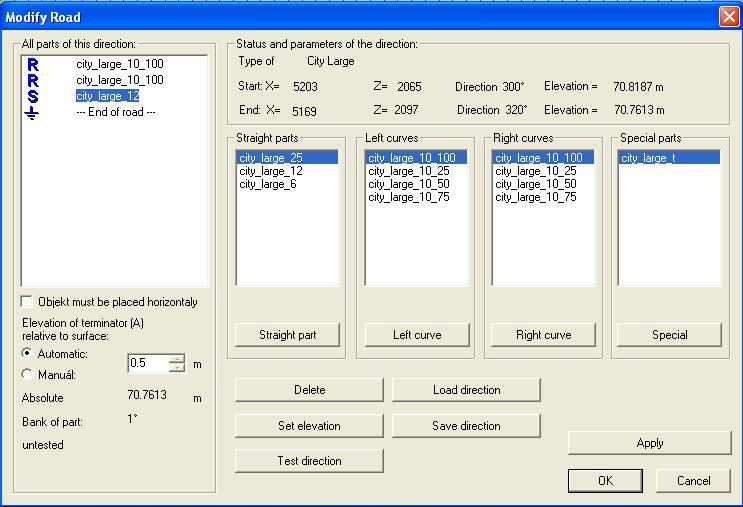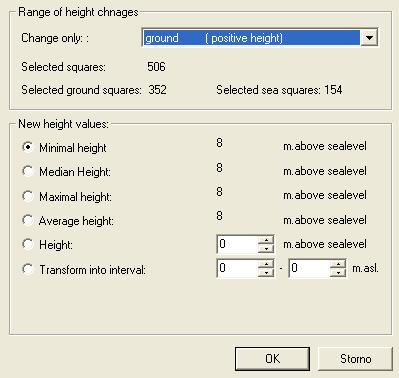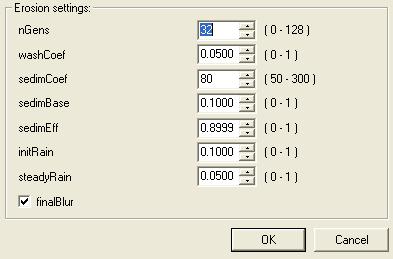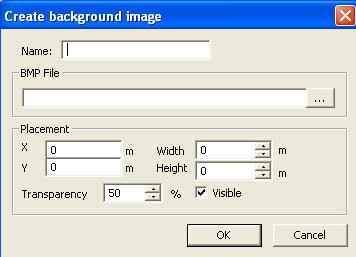Visitor 3 Manual
Introduction
This manual will explain the basic functions of Visitor 3, the terrain and landscape editing tool for Armed Assault.
Version 3 of Visitor has improved features over its predecessors:
- Easier object handling
- All operations are much faster (especially with large number of objects)
- Support for surface materials rvmat and new transition materials bimpas
- Import/Save landscape profiles from/to images (.png format)
- Completely in English
- Improved road networks creation
- Script support (.vis)
- Background overlay images
- Source control integration
- Reworked and polished UI allowing docking of toolbars etc.
Installation and Setup
In case you do not have it already installed you need also Buldozer, which will act as 3D viewer. Even if you can install Buldozer everywhere, we recommend to place it directly in your main working folder (standard location is p:\), since it ensures the right working environment.
First thing you should do is to click Tools\System Preferences to set the path to realtime viewer working directory (standard is p:). All path indications will be relative to this path, so if something does not work as expected you should check there first.
Also define the call parameters for the viewer:
Syntax: PathToBuldozer\arma.exe [-window] [-cfg=PathToConfig]
Commands in [] are optional (leave [] away when using that command):
PathToBuldozer : Path to the folder where arma.exe is located (standard is p:\)
-window : Starts Buldozer in window instead of full screen
-cfg=PathToConfig : Forces Buldozer to use a certain config. By default Buldozer uses Buldozer.cfg located in the same folder as buldozer.exe
-addons=ofp2addons.txt : File containing necessary addons, if you want to see correct clutter settings for edited world, its folder must be mentioned in p:\ofp2addons.txt
Example of file ofp2addons.txt with paths to addons:
addons[] = {
//paths to addons
"ofp2\", "ofp2\maps\", "ofp2\debug\", "ofp2\UI\",
//path to addon of edited world
"ofp2\maps\surfaces\grassland\"
};
Please, mind that described path must end with backslash - \, otherwise it will be considered as file, not path.
p:\Arma.exe -buldozer -window -addons=ofp2addons.txt -cfg=P:\Buldozer.cfg
ofp2addons.txt must be located on the root of disk P, it is a list of addons, configs of these addons will be used.
Example setup of Arma model folders is as follows:
P:\ca\buildings P:\ca\roads P:\ca\misc P:\ca\plants
Example of location of custom Island could be:
P:\<my_mod>\<islandname>\ -> Folder for config and wrp P:\<my_mod>\<islandname>\data -> Folder for ground textures and rvmat files P:\<my_mod>\<islandname>\data\layers\ -> Folder for satellite textures, mask and rvmat files (all auto generated by Visitor3 PE including layers folder)
Interface
Most of the buttons are self-explanatory, so only the important ones need to be explained. If you used old version of Visitor you will notice that the buttons for selections and object handling have disappeared, since this is now done over a combination of Shift/Ctrl and mouse-clicks.
Most important in first line of tool buttons are (to start Buldozer) and
(to align the map to window).
contains additional filters and view options.
The actual view is shown in the map-window:
The current editor-mode is shown in this window:
MMB (Middle mouse button) points cursor on new location.
RMB (Right mouse button) is used for panning the map.
LMB (Left mouse button) deselects/selects/places objects/surfaces.
For selecting areas press and hold the left mouse-button (LMB) and move it over the area.
For additional areas to the already selected one, press CTRL+LMB.
For excluding areas use SHIFT+LMB.
For selecting an object on map, click on it with the LMB.
To select several objects drag a selection box around them or use CTRL+LMB to add them to selection.
To rotate one or several selected object(s), hold CTRL (or SHIFT), click on them an move your mouse up or down.
How to Make Your First Map
- Create new project ( Project -> New , Ctrl + N )
- Select wanted size (e.g. width 2000 m, square size 50 m)
- Set project preferences ( Tools -> Project preferences... ), fill in basicmap\data to Folder - Textures field
- Select entire map area (Edit -> Select All , Ctrl + A)
- To change height of the map, switch to Terrain Vertices editing mode (F5) and select "Change height...", in the dialog Change height select Height option and fill in Height field desired value (e.g. 100 m above sea level)
- Open realtime viewer (Project -> Connect to buldozer, Ctrl + F7)
- To get Satellite and ground textures in game you follow these two articles; article, article, once completed you can import all using Tool -> Import Satellite + Mask.
- To export your map for the engine, select Project -> Export world... , and store it to basicmap\basicmap.wrp , realtime viewer has to be running.
Tools
Textures
This method is no longer used. See Layered Terrain Surface Representation instead.
Natural Objects
All flowers, bushes and trees used on the map will be defined here.
- "Add": Add an object, browse the opening list to select the model you want to use. Note that you have here a maximum length for a name of 50 characters.
- Randomize Size Interval: Model size will be randomly set in the given interval when placed in Visitor.
- Randomize Angle Interval: Model angle will be randomly set in the given interval when placed in Visitor.
- Randomize Orientation Interval: Model facing direction will be randomly set in the given interval when placed in Visitor.
Artificial Objects
Structures definitions.
All artificial objects, like buildings, walls or street signs are defined here.
Same as in Natural Objects.
Roads
Road types and sections definitions go in here.
After hitting "Add" or "Edit" the Main setting window for the road shows up.
- Road: Main settings for given road type.
- Straight Parts: all straight sections of this road type.
Note that those parts need a certain length: 6.25, 12.5 or 25 meters.
- Curves: all curved section of this road type.
Note that those parts need a certain radius: 25, 50, 75 or 100 meters.
- Special Parts: Sections with special appearance like a T-shape. Same way defined as straight parts.
- Terminators: Sections that ends a road.
Forests
Todo. Forest definitions. Generally, forests are obsolete concept and shall be replaced by individual trees or more universal solution for placing object. Usage of random object placer scripts is recommended for placing large forested areas.
Project Preferences
Paths to textures and objects (if stored in a specific place) and other project specific settings.
- Folder - Textures: Path to the folder where all landscape textures are stored.
Note that the path is saved relative in the map, so you have to maintain folder structure.
- Folder - Objects: Path to the folder where all objects used in Visitor are stored. This path is also relative saved.
- Square Size: In game side length of one square in visitor.
Object Manager
TO DO!!
Replace Objects
Deletes or replaces all instances of an object (models) from the map.
Random Object Placer
(This tool appears not to be included in the Visitor3 PE RC)
Places objects in a random pattern within an area. The settings for random placing can be defined and will be stored in configuration profiles for later further use. This can be used for light forests.
- Template: Object used, the object is either defined under Natural Objects or Artificial Objects.
- Density: Density of that Object per square.
- Collision free: Defines if the object needs to be placed collision free (for example, buildings or trees).
Snap Objects
Closes small gaps that can occur when placing objects like fences, walls. Note that objects need to be prepared for snapping.
Editing Modes [F1-F10]
Landscape - Textures
Obsolete.
Artificial Objects [F1]
Placing all artificial objects (houses and other structures), except roads.
List of all artificial objects. Select an object and click on the map where you want to place it.
Natural Objects [F2]
Placing all natural objects, except forests.
List of all natural objects. Select an object and click on the map where you want to place it.
Road Networks [F3]
Placing roads.
List of all road types. Select a type and click on the map where you want to place it. A dialog will pop up leading you through the placement process.
Note: You only have to place the first key part of a road section. Then you can simply click on the map and Visitor will try to reach the point, autoplacing the road.
In case you don't like the placement you can change it manually, which is a bit more time consuming.
If you click on a placed road, the road property window will show up.
Every road part (except terminators) have two main directions: A and B, reflecting both ends of that key section. Visitor uses the closest end of a road to reach a point clicked on the map.
- Orientation Of Key Part (Direction A): Direction the A end is facing, angles are only possible in 10° steps.
- Position X and Position Z: Position of the key part on the map.
- Gen.Terminator: Creates Terminator or new Key section at the end of that direction
- Modify Dir. A:
Note: -Deleting/Adding a part in the middle of the road changes also the rest of the road.
-Added sections will be inserted before the section marked in "All Parts Of This Direction".
- All Parts Of This Direction: All sections from the key section to the end of the road
- Delete: Delete selected section.
- Straight Part: Adds the selected straight part to the road.
- Left Curve: Adds the selected left curve section to the road.
- Right Curve: Adds the selected right curve section to the road.
- Special: Adds the selected special section to the road.
Key Points [F4]
Display/Create key points.
List of all key points on the map. To add key points, click LMB on the map in this editing mode.
Same options as in [[#Named Zones [F7]]] editing mode.
Terrain Vertices [F5]
Landscape height changing. Landscape forming tool.
Change Height: Changes the height of points/area on the map.
- Change only: Shows only up when the selection has sea and land points.
Ground (Positive Height): Only points over sea level will be changed. Sea (Negative Height): Only points below sea level will be changed.
- Minimal Height: All points will set to the height of the lowest point of selection.
- Median Height: All points will set to the median height of selection.
- Maximal Height: All points will set to the height of the highest point of selection.
- Average Height: All points will set to the average height of selection.
- Height: All points will set to this height.
- Transform Into Interval: Takes the current height profile of selection and stretches it into the given interval.
Erosion: Erodes Landscape.
- nGens: Number of generations of erosion (max. 128 generations).
- WashCoef: Wash Coefficient, how strong does water flow affect terrain.
- SedimCoef: Sediment Coefficient, how fast sediments sink down and stay where they are.
- SedimBase: Sediment Base, how much sediment is there from the beginning.
- SedimEff: Sediment Effect, "wash out" resistance of terrain.
- Initrain: Strength of rain.
- SteadyRain: How long does the rain last.
- FinalBlur: Creates a smoother surface.
Background Images [F6]
Sets a backgroundpicture as reference. Only bmp files are supported.
To see the background image, in the "Create background image" dialogue (below), first choose some BMP file. Placement values are coordinates for top left corner (for the image covering whole map, set both to 0). Width and Height are true sizes of imported image. Example: If the map is e.g. 10240x10240 meters and the background image covers whole area, set Width and Height values to 10240.
Smaller hi-res images can be used as well, if the coordinates and size are set correctly.
Named Zones [F7]
Display/Create named zones.
List of all named zones on the map.
To name a zone click LMB on map screen the selection box.
- Go To...: Centres the view on selected zone.
- Properties: Opens properties window (same as double clicking the selection).
- Select Objects In Zone: Selects all objects that are in this zone.
- Select area under zone:
...
Named Objects [F8]
Browser for all named objects on the map.
Surfaces (OFP) [F9]
??
Woods [F10]
Creating old style forests which isn't used any more, ArmA forest now consist of many single trees and bushes.
Terrain
You have several options to edit the height profile of your map:
- Manually ("Terrain Vertices" as editor mode/F5): This is the most work intensive version, you change all landscape point individually. We recommend to use this method only for fine tune a map.
- Import ASE Height Map (Projects/Import Terrain): Read in an 3D Studio Max .ase height map. This will be more likely removed in future.
- Import PNG Image (Projects/Import from Picture): Imports 8 or 16 bit PNG image, a PBL config must be present (it's created automatically when you export PNG file in the same location). PBL file example:
class cfg
{
PNGfilename="world.png";
squareSize=5.000000;
originX=0;
originY=0;
minHeight=120.000000;
maxHeight=735.000000;
};
- Import from XYZ map (Projects/Open "Files of type: *.xyz"): XYZ is ASCI file format containing space delimited X Y Z on each line, where XY is UTM and Z is in meters. During import you can align data to top or bottom left and set target data dimension to crop data or extend area.
- Inside Buldozer: You can use U (small step up), I (big step up), J (small step down) and K (big step down). This is also best used for fine tune the profile.
Note: for import terrain operations (and any other large scale operations like this) it's recommended to disconnect buldozer otherwise it takes really long time to process the map.
Scripts
Visitor 3 gives you the opportunity to use scripts for certain tasks. Visitor script files have the extension .vis.
Your Old Flashpoint Map Project to Arma Map Project By Ivan
To avoid conflicts arising from simultaneous use of old and new projects in V3, the idea is to have a clone of the old project and transferring there old content using scripts. Since Visitor works with VISITOR OBJECT NAMES, not with MODEL NAMES, it makes the task easy. Keep old project untouched as reference and source for exporting content. Tutorial is based on assumption that you have p:\ as virtual working drive.
Make target project
You will need to make project with same dimensions as old OFP map. - Make new project in Visitor. - Specify width/height: 12800 m. Square size is 50 m.
Project Preferences - Specify some important variables before you start
Let's set paths to objects and correct satellite grid number. For Arma maps, we use following settings in Project Preferences: Textures folder: p:\ca\abel\data Objects folder: p:\ (We can use all objects from all available PBOs this way, you will be able to use Arma objects this way). Square size: should be 50 meters in your case Satellite grid: Calculate proper number using the tutorial Layered Terrain Surface Representation, OpenOffice table or updated version of V3. The goal is to enter correct number so that Visitor will cut imported HUGE texture into 512x512 bits. 512x512 is important, it is best choice for good performance. I used value 16 for Abel, "satellite" texture size was 6400x6400 px.
Detail Texture Resolution Setting
You need to set proper size of area, on which detail textures will be mapped. On Arma islands, we use 40 meters, all textures are made in order to fit to this size. You will probably need to tweak size of original textures to fit your map's values. Clutter density values can be updated accordingly. - Make sure you have Panel of Objects visible (set in View menu). In Panel of Objects, choose "landscape-textures" from first roll-down menu. - On the bottom of panel, there is Layers space, there should be one line. RMB on it and choose to Edit layer. - Name of layer is not important. Name it as you wish. - Resolution IS important. Note that available values are ([terrain size]*2expN). For big maps, you may use quite big number (~100-200 meters, ugly look guaranteed). For Abel, I chose 50x50 meters. Using Sahrani surfaces as they are will thus make them look 1.25x bigger, they stretch on surface 25% bigger than on Sahrani.
Objects
Transferring objects is not a big issue. You just need to name new object in new project EXACTLY SAME as in old one. Then you may use two ways of inserting objects. - E.g. there is object "kostelik" (=little church) in old project. Path to model is ..\Data3d\kostelik.p3d. In new project, make object with same visitor name, updated Arma counterpart is ..\ca\buildings\kostelik.p3d - Now the first way of copying it, quite suitable for copying vegetation because it saves relative size of object: Select objects of this kind in old project, copy them (Ctrl+C). In new project, go to "Edit"-> "Paste absolute" (or Shift+V) and objects should be copied on their exact locations. - Second way is script way: We made ExportObjects and ImportObjects scripts, which are part of V3 distribution. You may add them to menu by going to "Scripts"->"Manage scripts", then add them from your Visitor3\Scripts. They are ExportObjects_100.vis and ImportObjects_100.vis. Now you can export data from old project (use default settings, specify path to *.txt file) and import them into new one.
Forests
You can forget about old forests. My suggestion is to either compose forest square mock-up and copy it or make new ones.
Roads
Same thing as 4. You will need to define all road parts in the same way as in original project. Then you just copy them and Paste-Absolute them into new one. Correct counterparts should be selected.

